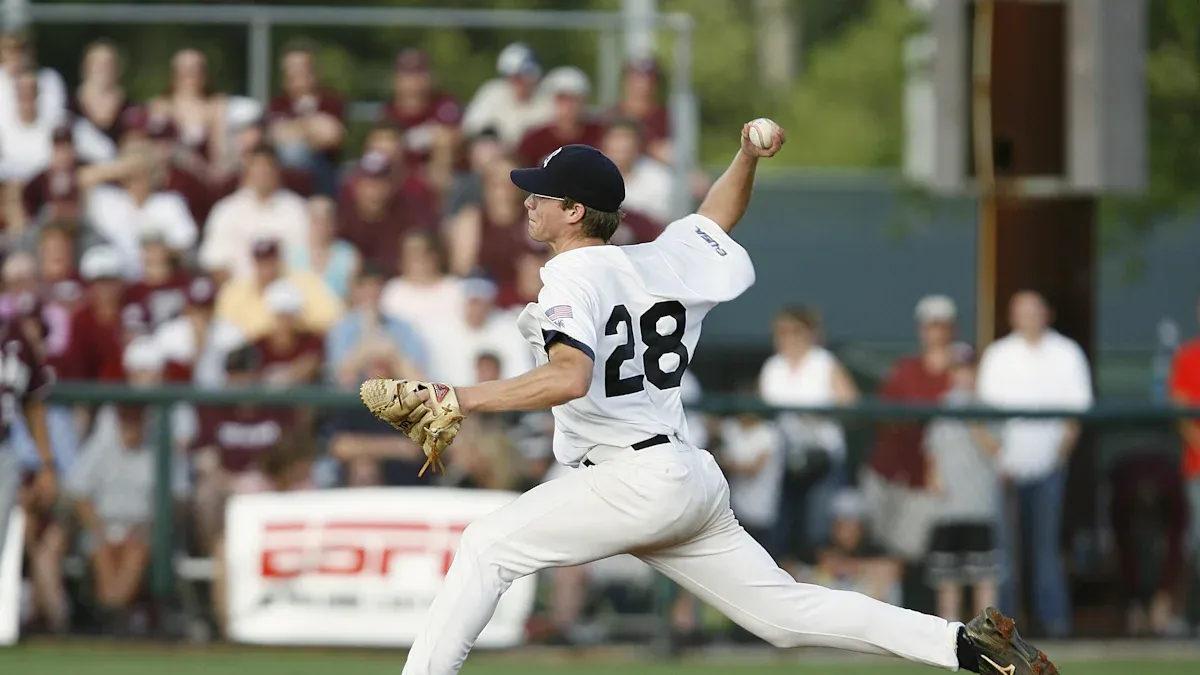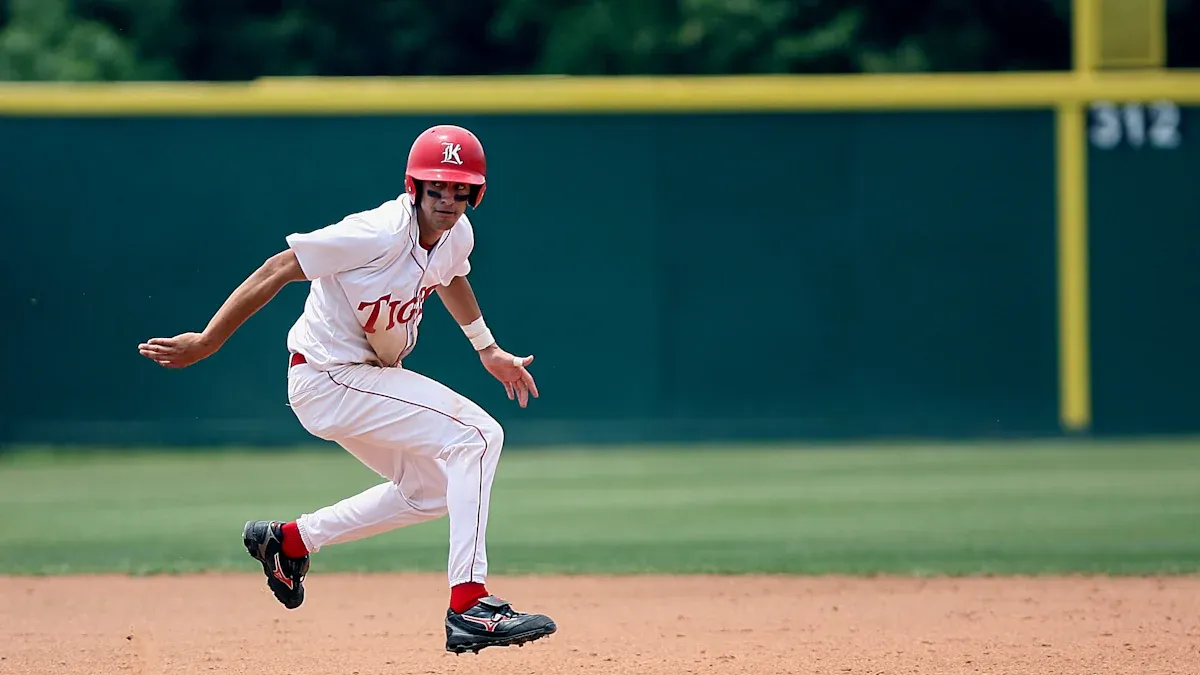
In baseball scoring, “K” stands for a strikeout. A strikeout happens when a batter misses three strikes in one turn. Over time, strikeouts have become more frequent in games. There is a strong link (0.96) between time and strikeouts per game. Teams now see strikeouts as a fair trade for stronger hits, including the ability to lob in baseball for strategic plays. This shift also changes strategies, like leaving runners on base after a strikeout.
Key Takeaways
In baseball, ‘K’ means a strikeout. This happens when a batter misses three strikes. Knowing this helps fans understand the game better.
Henry Chadwick, called the ‘Father of Baseball,’ made the scoring system. He picked ‘K’ for strikeouts to prevent mix-ups with other symbols.
Strikeouts happen more often now, changing how teams play. Teams study strikeout numbers to get better and make smarter choices.
The Origin and Meaning of ‘K’ in Baseball

Henry Chadwick’s role in baseball scoring
Ever wonder how baseball scoring became so organized? Henry Chadwick, known as the “Father of Baseball,” helped create the system we use today. In 1859, he made the first modern box score for the Brooklyn Excelsiors. This tracked runs, hits, putouts, assists, and errors. It helped fans and players understand the game better.
Chadwick also came up with using ‘K’ for strikeouts. He wanted scoring to be simple and easy to follow. But he didn’t stop there. He also created stats like batting average and slugging percentage, which are still used now.
Contribution | What It Did |
|---|---|
Modern Box Score | Made in 1859 to track runs, hits, putouts, assists, and errors for the Brooklyn Excelsiors. |
Strikeout Abbreviation ‘K’ | Used ‘K’ for strikeouts, taking it from the last letter of ‘struck’. |
In-Game Scoring System Framework | Built the scoring system that is still part of baseball today. |
Chadwick’s ideas made baseball easier to watch and study. His system became the base for how we understand the game now.
Why ‘K’ was chosen to represent strikeouts
You might think ‘S’ would make more sense for strikeouts. But Chadwick picked ‘K’ for a reason. He wanted to avoid confusion with other symbols, like ‘S’ for sacrifice. The ‘K’ comes from the last letter of “struck,” a word used for strikeouts.
This wasn’t a random choice. Chadwick wanted a scoring system that was clear and easy to remember. Using ‘K’ made it stand out and avoided mixing it up with other letters.
Fun Fact: Chadwick explained his choice in an 1888 article in Outing magazine, where he shared his scoring ideas.
How ‘K’ became a standard in baseball scoring
The use of ‘K’ for strikeouts didn’t catch on right away. Chadwick first used it in 1861 when he explained his scoring system. Over time, more people started using it. By 1946, ‘K’ was common in baseball headlines, like in the San Francisco Call-Bulletin.
Year | What Happened |
|---|---|
1861 | Chadwick explains his scoring system and picks ‘K’ for strikeouts. |
1888 | Chadwick writes about his choice of ‘K’ in Outing magazine. |
1946 | ‘K’ becomes popular in headlines, like in the San Francisco Call-Bulletin. |
Today, ‘K’ is everywhere in baseball. You see it on scoreboards, in box scores, and even on fan signs at games. This one letter has become a key symbol for one of baseball’s biggest plays.
Types of Strikeouts and Their Representations

Swinging strikeout and the forward ‘K’
A swinging strikeout happens when a batter swings and misses. This occurs on the third strike. In scoring, it is shown with a forward ‘K.’ This means the batter tried to hit but failed. Swinging strikeouts show how skilled pitchers can trick batters. They use pitch speed, movement, or placement to confuse hitters.
Pitchers with high Whiff Rates cause many swinging strikeouts. Whiff Rate shows how often batters miss when swinging. These pitchers often throw fastballs or tricky breaking balls. A high Whiff Rate shows they can overpower or outsmart batters. Swinging strikeouts are a sign of their pitching skill.
Looking strikeout and the backward ‘K’
A looking strikeout happens when a batter doesn’t swing at strike three. The umpire calls it, and it’s marked with a backward ‘K.’ This shows the batter misjudged or was surprised by the pitch.
Looking strikeouts happen because of a pitcher’s accuracy. They throw the ball where the batter doesn’t expect it. This frustrates batters and shows hesitation or poor pitch reading. For pitchers, it shows control and the ability to find batter weaknesses.
The importance of distinguishing between strikeout types
Knowing the difference between swinging and looking strikeouts is helpful. It shows how players perform. Stats like Whiff/Swing and SwStr% show how often batters miss when swinging. High Whiff Rates mean pitchers are strong, while low rates show batters make good contact.
Statistic | Description |
|---|---|
K% | How often a player strikes out per plate appearance. |
BB% | How often a player walks per plate appearance. |
Context | Strikeout and walk rates change over time and eras. |
Approach | High K% and low BB% mean aggressive hitters. High BB% shows patient hitters. |
By knowing strikeout types, you learn about pitcher strategies and batter styles. This helps you understand the game better.
The Significance of Strikeouts in Baseball
Statistical metrics for strikeouts (e.g., K%, K/9)
Strikeouts are not just exciting moments in baseball. They are also important for judging how well players perform. Two key stats for strikeouts are strikeout percentage (K%) and strikeouts per nine innings (K/9).
K% shows the percentage of batters a pitcher strikes out. For example, if a pitcher has a 25% K%, they strike out one in four batters. This stat helps compare pitchers from different times, though its meaning can change with playing styles.
K/9 calculates how many strikeouts a pitcher gets in nine innings. Unlike K%, it doesn’t consider how many batters the pitcher faces. This can make it less accurate in some cases.
Metric | What It Measures | Comparing Eras |
|---|---|---|
Strikeout % (K%) | Percentage of batters faced that result in strikeouts. | A 25 K% in 1985 means something different than a 25 K% in 2015. |
Strikeouts per 9 Innings (K/9) | Average number of strikeouts per nine innings pitched. | K/9 ignores the number of batters faced, which changes across eras. |
Why It Matters | Both stats are key for judging pitchers. | Metrics like K% and K/9 predict success but mean different things depending on the time period. |
Strikeouts have become more common over the years. In 2005, 16% of plate appearances ended in strikeouts. By 2020, nearly 25% of plate appearances ended this way. This rise shows changes in how pitchers and batters approach the game.
Impact of strikeouts on pitchers and batters
Strikeouts affect how both pitchers and batters plan their games. For pitchers, a high strikeout rate shows they are strong and in control. It proves they can beat hitters with speed, movement, or pitch placement. Today’s pitchers use advanced stats to find batters’ weaknesses, leading to more strikeouts.
Batters now focus more on hitting home runs. Many are okay with striking out more often if it means hitting the ball harder. This focus on power has raised strikeout rates but also created more exciting plays.
Pitchers study data to find patterns in batters’ swings.
Batters aim for big hits, even if it means striking out more.
MLB rule changes have helped pitchers, causing strikeouts to increase.
In 1887, the four-strike rule was introduced. This rule briefly lowered strikeouts and increased hits. It showed how changing strikeout rules could affect offense and game results.
Year | Percentage of Plate Appearances Ending in Strikeouts |
|---|---|
2005 | 16% |
2020 | Almost 25% |
Notable strikeout records in baseball history
Strikeouts have created some of baseball’s most famous moments and records. Great pitchers like Nolan Ryan and Randy Johnson became legends by striking out many batters. Teams also use strikeouts as part of their winning strategies.
Team | Strategy Used | Result |
|---|---|---|
Boston Red Sox | Ended 86-year championship drought in 2004 | |
Houston Astros | Used data to find undervalued players. | Won the World Series in 2017 |
St. Louis Cardinals | Used data to succeed despite having less money. | Made playoffs often |
Tampa Bay Rays | Used creative analysis to stay competitive on a small budget. | Stayed competitive with limited resources |
Some of the most amazing strikeout moments include games where pitchers set records. The chart below shows strikeout milestones and unusual stats from different years.

Strikeouts are more than just numbers. They show how baseball strategies have changed, how skilled pitchers are, and how batters’ goals have shifted. Learning about these trends and records helps you understand the game’s history and complexity better.
The Role of Strikeouts and Lob in Baseball
How strikeouts influence game strategy
Strikeouts are important for baseball strategies. Pitchers try to stop batters from hitting the ball. This lowers the chance of hits and keeps bases empty. Teams use data to improve their plans. For example:
A team with a 25% strikeout rate and 7% walk rate might practice better plate discipline.
Managers use stats to pick the best pitchers for certain batters, increasing strikeouts.
Batters work hard to avoid striking out. They may change their swing or timing to hit better. Teams also teach batters to spot tricky pitches and avoid bad swings. Strikeouts affect everything, from player choices to game tactics.
The connection between strikeouts and lob in baseball
Strikeouts affect lob, which means “left on base.” When a batter strikes out, runners stay on base unless another player gets a hit. This lowers the team’s chance to score. High strikeout rates cause more lob situations, making teams rethink their offense.
Pitchers use strikeouts to control the game. Striking out batters stops them from moving runners or scoring. Batters try not to strike out to keep the inning going and reduce lob. Teams study these trends to play better.
Strikeouts and lob are closely connected. Knowing this link shows how teams balance offense and defense to win.
The letter ‘K’ stands for a strikeout in baseball. Henry Chadwick chose it to make scoring simple. Strikeouts are key moments that affect game strategies. In the last six seasons, MLB strikeout rates were over 3.5% in five years. This shows how important strikeouts have become.
Year Range | MLB Strikeout Rate Trend | KBO Strikeout Rate Trend | Gap Between Leagues |
|---|---|---|---|
2002-03 | No drop year-to-year | Changed each year | N/A |
Last 6 Seasons | Over 3.5% in 5 years | N/A | Big gap seen lately |
Learning about ‘K’ helps you understand baseball’s history and changes.
FAQ
What does a backward ‘K’ mean in baseball scoring?
A backward ‘K’ means the batter didn’t swing at strike three. It shows the pitcher’s skill and the batter’s mistake.
Why is ‘K’ used instead of ‘S’ for strikeouts?
Henry Chadwick picked ‘K’ to avoid mixing it with ‘S.’ ‘S’ was already used for sacrifice, so ‘K’ came from “struck.”
How do strikeouts impact a team’s strategy?
Strikeouts leave runners on base, lowering scoring chances. Teams study stats to improve hitting and pitching strategies.
